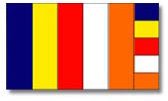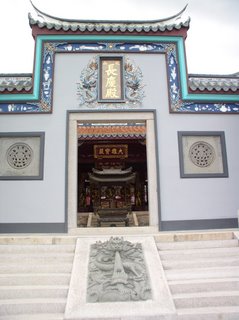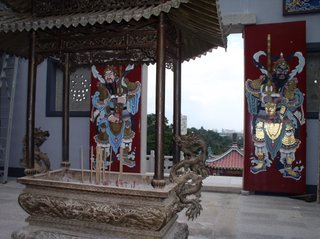Thursday, May 11, 2006
Thrice Sacred Day
Buddhists commemorate 3 historical blessed occasions on Wesak Day : the Birth of the Bodhisatta (Buddha to-be), the Enlightenment of the Bodhisatta (now called the Buddha) and the final Passing Away of the Buddha.
His Birth is a blessed occasion because He came out of compassion for all beings. He has toiled for many lifetimes perfecting the 10 perfections before finally achieving the required results. Thus, a Bodhisatta was born, fulfilling His vow to show all beings the way out of suffering.
 On the Full Moon Day of Vesak month, 625 B.C.E., the Buddha to be (Bodhisatta) was born in Lumbini Park. Immediately after being born, he walked for seven steps, and there was a lotus holding him up at every step. He said he was the most exalted one in the world.
On the Full Moon Day of Vesak month, 625 B.C.E., the Buddha to be (Bodhisatta) was born in Lumbini Park. Immediately after being born, he walked for seven steps, and there was a lotus holding him up at every step. He said he was the most exalted one in the world.His Enlightenment is a blessed occasion because His enlightenment itself shows that all human beings can attain the highest mental purity without relying on external forces. Salvation is won by destroying greed, hatred and delusion. The Buddha Himself has walked the Path, and now He has taught the Dhamma for the sake of all beings with compassion. His Enlightenment opened the Door to Deathlessness again!
 At dawn on the Full Moon Day of Vesak month, 588 B.C., the Buddha was enlightened on the Four Noble Truths, i.e., Suffering, the Cause of Suffering, the Cessation of Suffering, and the Way leading to the Cessation of Suffering. From then on began his mission to share the Dhamma with all beings who have little dust in their eyes so that they may attain Nibbana as he did. Buddhists who attained various stages of sainthood continue to spread the Noble Teachings today.
At dawn on the Full Moon Day of Vesak month, 588 B.C., the Buddha was enlightened on the Four Noble Truths, i.e., Suffering, the Cause of Suffering, the Cessation of Suffering, and the Way leading to the Cessation of Suffering. From then on began his mission to share the Dhamma with all beings who have little dust in their eyes so that they may attain Nibbana as he did. Buddhists who attained various stages of sainthood continue to spread the Noble Teachings today.The Buddha's final Passing Away is a blessed occasion because He is free from Suffering forever. He is not trapped in the process of birth and death anymore. Thus is His glorious passing away!
 The Buddha entered into Pari-Nibbana at the Sal grove in Kusinara city, 543 B.C.E., after preaching for the welfare of the people for forty-five years. His last message was :
The Buddha entered into Pari-Nibbana at the Sal grove in Kusinara city, 543 B.C.E., after preaching for the welfare of the people for forty-five years. His last message was :"Appamadena Sampadetha Vaya Dhamma Sankhara."
"Work diligently. Component things are impermanent." (Maha Parinibbana Sutta)
How to honour the Buddha on this day? Read Ajahn Lee Dhammadaro's sermon at :
http://216.197.193.235/Dhamma/Talk/LeeVesak.htm
(Mandarin)
http://www.accesstoinsight.org/lib/thai/lee/visakha.html
(English)
Wednesday, May 10, 2006
Year Of Our Lord Buddha 2550, A Reflection

Buddhism began with Siddharta Gautama rediscovering the same Dhamma that leads to Nibbana which other Buddhas have discovered and unfolded. With that begin the Buddha’s noble mission to share the Dhamma with those beings whose eyes are covered with little dust. Since the Buddha’s time until the present moment, countless beings, from human beings to demons, kings to murderers, all who had the rare chance to listen and practice the Dhamma have benefited and attained various stages of sainthood. However, nothing is permanent, declared the Lord Buddha, including the Noble Buddha’s Sasana (Buddhism).
 In Dhammapada 182, the Buddha said, “Hard to get is the human birth; difficult is the life of a mortal. Difficult is listening to the True Dharma; hard to come by is the appearance of the Awakened Ones (甚難獲得此人身,有死生命真難過,欲聽正法真是難,甚難會有佛出世。).”
In Dhammapada 182, the Buddha said, “Hard to get is the human birth; difficult is the life of a mortal. Difficult is listening to the True Dharma; hard to come by is the appearance of the Awakened Ones (甚難獲得此人身,有死生命真難過,欲聽正法真是難,甚難會有佛出世。).”This Wesak marks 2,550 years of the Dhamma’s endurance in this world. If we reflect on what the Buddha said in Dhammapada 182, The Buddha had passed into Nibbana 2,550 years ago : that means no chance to see the Buddha! However, we are still fortunate to be able to study the Dhamma in its pristine form as preserved in the Tipitaka Pali and most importantly, we are born human! Imagine, being born in a place where the Buddha’s teachings are unknown, worst still being born in the four woeful planes (the realms of hell, hungry ghost, animals and asuras)! Being binded by bad kamma is bad enough, to perform unwholesome deeds through not knowing the Dhamma is even worse! The chain of kamma bind us even tighter in this Samsara!
Therefore, as long as the Dhamma still flourishes, we should make an effort to be better Buddhist! Those who are fortunate to thread on the Noble Eightfold path break the chain and attain Nibbana. Worldlings like us, who are still wandering in Samsara, should take heed the Buddha’s words :
於諸道之中,八聖道最勝;於諸諦之中,四聖諦最勝;於諸法之中,離欲(即涅槃)最勝;於諸二足(人類)之中,一切知者最勝。The Eightfold Path is the best of Paths. The best of truths are the Four Truths. The best of mental states is absence of passion. The best of people are the ones with insight. (Dhammapada 273)
這是唯一的道路,再無其他知見清淨之道。實踐此道能令魔王迷惑。This is the path. There is no other for the purification of insight. Enter upon this path. This is the deception of Mara. (Dhammapada 274 )
實踐此道,你將能滅苦。在親自知見這能拔除煩惱之刺的道路後,我對你們宣說此道。Having entered upon this path, you will make an end of suffering. Having realized how to remove the arrow, I taught this path to you. (Dhammapada 275)
你必須自己努力,如來只能指示道路。修禪者得以解脫魔王的束縛。(註:一切知者與如來都是佛陀的名稱。)You must make an effort. The Buddhas are only teachers. Those, who meditating entered upon this path, will be released from the bond of Mara. (Dhammapada 276)
We ourselves must walk the path. The Buddha settled His problem. He has shown us the way. The Buddha wants us to realize that we have wandered in Samsara long enough. We have become slaves to our greed, hatred and delusion for a very long time. With the Dhamma, we should learn to be above these three poisons that caused us enough suffering for millions of lifetimes!
Truly it is only by practice that Nibbana is attained! The value of a person who accepts the Buddha as his teacher, the Dhamma as his guide and the Sangha community as an inspiration (in other words, a Buddhist) is not in the number of times he does chanting, the number of times he goes to temple, the number of joss sticks he burns but the value lies in the Dhamma he practices.
A Buddhist who doesn’t know the Buddha’s teachings should start learning what he missed out! A Buddhist life is aimed at eradicating suffering through attaining Nibbana, it is not about doing mysterious rituals. Walk the Noble Eightfold Path and your're on the way towards Nibbana!
Knowing the Buddhist flag
The first five stripes of the flag are of five colours.

The sixth colour is a conglomeration of the five, but for the design, it has been separated into its constituent colours.
The Buddhist flag, first hoisted in 1885 in Sri Lanka, is a symbol of faith and peace used throughout the world to represent the Buddhist faith.
The six colors; Blue (nila), Yellow (pita), Red (lohita), White (odata), Scarlet (manjestha), and the mixture of these six colors (prabaswara) of the flag represent the colors of the aura that emanated from the body of the Buddha when He attained Enlightenment under the Bodhi Tree.
The Horizontal Stripes represent the races of the world living in harmony and the Vertical Stripes represent eternal world peace.
The colors symbolize the perfection of Buddhahood and the Dharma.
The Blue light that radiated from the Buddha's hair symbolizes the spirit of Universal Compassion for all beings.
The Yellow light that radiated from the Buddha's epidermis symbolizes the Middle Way which avoids all extremes and brings balance and liberation.
The Red light that radiated from the Buddha's flesh symbolizes the blessings that the practice of the Buddha's Teaching brings.
The White light that radiated from the Buddha's bones and teeth symbolizes the purity of the Buddha's Teaching and the liberation it brings.
The Orange light that radiated from the Buddha's palms, heels and lips symbolizes the unshakable Wisdom of the Buddha's Teaching.
The Combination Color symbolizes the universality of the Truth of the Buddha's Teaching. (Burmese Buddhist replaced with Pink.)
Regardless of race, nationality, division or color, all sentient beings possess the potential of Buddhahood.
The colonel's flag later came to symbolize the unity of Buddhists.
Thereafter, it has been used worldwide and has been used in nearly 60 countries during Buddhist festive seasons, particularly during the Vesak celebrations.
Colonel Olcott was one of the greatest American Buddhists who dedicated his later life entirely to the people of Asia. He is known as the father of the Buddhist education movement since he initiated the establishment of close to 400 Buddhist schools and colleges in Sri Lanka.
Theravada sites in Chinese language
http://216.197.193.235/Dhamma/DhammaIndex.htm
http://myweb.ncku.edu.tw/~lausinan/
Dhammapada (法句經) : http://myweb.ncku.edu.tw/~lausinan/Tipitaka/Sutta/Khuddaka/Dhammapada/Dhammapada.htm
Chanting, download mp3 : http://216.197.193.235/Dhamma/Chanting/ChantIndex.htm
Introduction to Paritta Chanting : http://www.bbt.org.sg/Articles/Pari_intro_ch.html
Paritta Chanting & meaning : http://www.bbt.org.sg/Articles/Paritta_chtr.html
Saturday, May 06, 2006
Visit to Sakka Devaraja's temple
 5th May 2006 : Went to 'Thee Kong Thua', the Chinese folk religion's highest ranking deity's temple. To most adherents of the Chinese folk religion, he's the highest ranking supernatural power. He commands and the world moves. He determines everything, he is the Creator of Everything. The Chinese thank Him for all blessings in life and attribute difficulties in life due to His divine test on humankind. Many devotees come to this temple due to its high rank and believe that all prayers done here will go straight to the highest power, thus making the prayer more potent.
5th May 2006 : Went to 'Thee Kong Thua', the Chinese folk religion's highest ranking deity's temple. To most adherents of the Chinese folk religion, he's the highest ranking supernatural power. He commands and the world moves. He determines everything, he is the Creator of Everything. The Chinese thank Him for all blessings in life and attribute difficulties in life due to His divine test on humankind. Many devotees come to this temple due to its high rank and believe that all prayers done here will go straight to the highest power, thus making the prayer more potent.A host of other Chinese favourite divinities are housed here including the Buddhas Shakyamuni, Amitabha and Medicine Buddha, Bodhisatvas Kuan Yin, Wei To & Kwan Gong, Chang Dao Ling (founder of mystical Taoism) , sages Lao Tzu (founder of philosophycal Taoism) & Kung Fu Tze (Confucious) , Dao Mu (9 Emperor Gods' Mother) , deities : Sun God, moon Goddess & OTHER divinities of nature.


